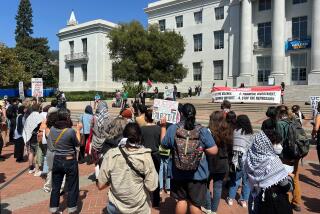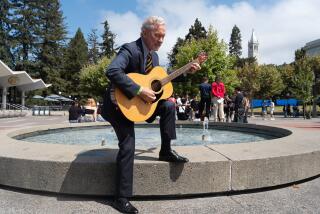Amid Budgetary Woes, University of Hawaii Hunts for a Rainbow
HONOLULU — Rainbows are such a familiar sight over the University of Hawaii’s verdant campus that the school’s sports teams are named after them.
Those rainbows are supposed to bring pots of gold, but in recent years the state university has found nothing but pots of woe.
Six straight years of budget cuts have resulted in faculty departures, higher tuition, declining enrollment, a critical accreditation report and a plummeting national ranking.
Although Gov. Ben Cayetano attributes the cuts to the state’s comatose economy, others say he’s targeting the university because he’s not an alumnus and the UH faculty supported his Republican opponent in last year’s election.
Either way, professors and alumni say they’re watching the slow death of a 92-year-old university that has educated all four members of Hawaii’s congressional delegation, former governors and much of the state Legislature.
“A downward spiral gathers momentum, and at some point you just can’t pull out anymore,” physics professor Michael Bevis said. “We may reach that point.”
Many public universities on the mainland faced budget crunches in the ‘90s, but UH’s troubles are perhaps more acutely felt in this isolated state, where the university is both the intellectual and athletic center of island life.
Now professors fear the school will lose its accreditation--a stamp of disapproval that would devastate the university’s ability to win research grants and attract top students and faculty.
“We used to have one of the best universities in the United States,” said Alex Malahoff, chairman of the school’s Department of Ocean Engineering and president of the faculty union.
The Western Assn. of Schools and Colleges reaffirmed UH’s accreditation in July but said it would revisit that in three years instead of the usual 10. The accreditation team criticized UH president Kenneth Mortimer for poor planning and communication in the face of budget cuts.
State funding of the 10-campus UH system has been cut every year since 1994 by a total of $41.5 million, or 13%. This year, Cayetano asked the university to trim $5 million from next year’s $278-million appropriation.
Relief is nowhere in sight, since Cayetano projects the state to run a $124-million deficit in four years.
“There’s going to be some pain, obviously,” Cayetano said. “People are going to have to manage their resources better.”
To deal with the shortfall, tuition has increased by more than 75%. At the same time, enrollment is down to 16,577 from more than 20,000 six years ago.
More than 400 faculty positions remain unfilled, and a somber mood prevails among many of the 2,000 remaining instructors.
“One could say that the majority of the faculty are hunkered down,” said David Yount, a physics and astronomy professor and faculty senate member. “They just want to be left alone. It’s too depressing for them to contemplate what’s happening to the university.”
In August, U.S. News and World Report ranked UH 152nd of 288 universities, down from 98th last year.
Mortimer denies the university’s accreditation is at risk but acknowledges that budget cuts are taking their toll. He said there may be no more fat to trim, so eliminating whole departments, programs or schools is possible.
Closing the John A. Burns School of Medicine is one idea that has been discussed but put off for now with the hiring of a new dean.
The School of Public Health, scheduled to lose its accreditation next June, likely will be incorporated into the medical school as a public health program.
In his annual state-of-the-university address, Mortimer played up UH’s strengths--marine sciences, tropical agriculture and Asian and Pacific Studies--and three record-setting years in raising outside research funding. UH pulled in $164 million last year.
Also, university scientists made international headlines last year by cloning three generations of mice and by helping discover that neutrinos have mass, which has far-reaching implications for astronomy.
“I continue to have great confidence in the University of Hawaii and its future in the state of Hawaii and in the country,” Mortimer said. “We have much to learn from each other, but we also have much to teach this state and the world about how to do things well.”
The 62-year-old administrator recently was jeered by student protesters who say he accepts budget cuts too easily. The student government printed buttons saying, “Axe the Axeman,” and some local politicians have demanded his resignation.
“[Mortimer’s] job is to maintain things are not that bad, but our job is to question things and say, ‘We have to do better,’ ” said student senator Antoinette Langcauon-Tenhunen, 28.
Mortimer has shared the hot seat with Cayetano, who some faculty members accuse of being unsympathetic to the school’s woes and of holding a political grudge.
Cayetano, a UCLA graduate, said talk that he is “anti-UH” distresses him.
“I think I have a stronger feeling for the school than some of the people who graduated from there,” he said. “It’s the only game in town for a lot of our kids.”
Cayetano has embarked on an ambitious plan to turn Hawaii into a high-technology center of the Pacific, but critics say his policies work against that goal by shrinking the pool of highly educated workers here.
“It seems to me when you’ve got an economy that is largely carried in just two baskets--tourism and agriculture--it’s incredibly crazy to basically destroy an engine that could start up new classes of industry and economic activity,” Bevis said.
More to Read
Sign up for Essential California
The most important California stories and recommendations in your inbox every morning.
You may occasionally receive promotional content from the Los Angeles Times.










